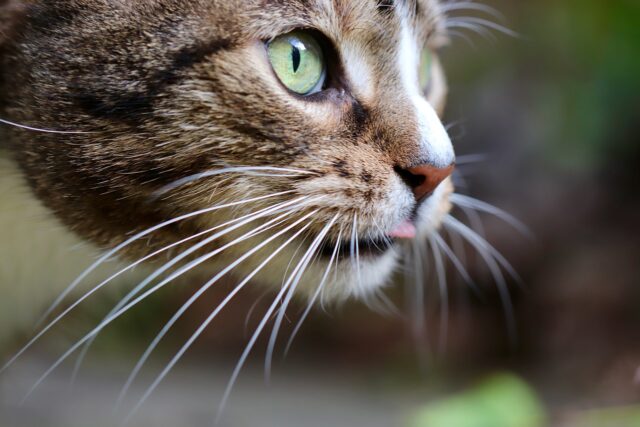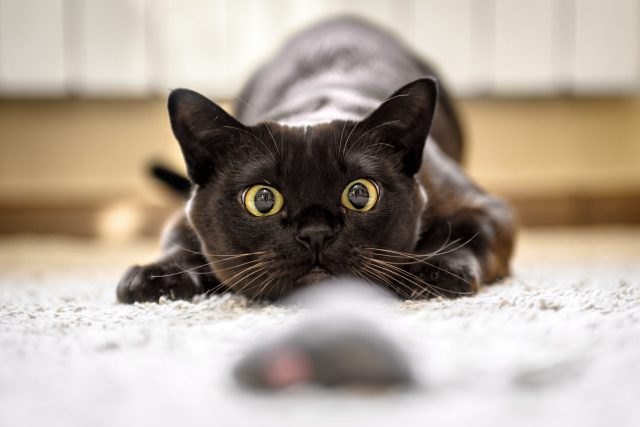Ever wonder why your cat pounces on anything that moves? From their laser-sharp focus to their stealthy paws, our feline friends are born hunters! Even the fluffiest lap cats carry the instincts of their wild ancestors. Let’s dive into the fascinating traits that make your cat a fearless hunter—because beneath that adorable exterior lies a tiny, skilled predator!

Instincts Sharpened by Nature
Your cat’s hunting skills aren’t just cute quirks—they’re survival instincts honed over thousands of years. Here are the key traits that make your feline a fearless predator!
#1 – A Powerful Sense of Smell

Your cat’s nose is a built-in tracking device! With up to 200 million scent receptors (compared to our mere 5 million), cats can detect prey, rivals, and even their favorite treats from impressive distances. Their sense of smell helps them determine whether something is worth chasing or if it’s just another boring houseplant. This heightened ability also plays a role in marking territory—your cat isn’t just rubbing on furniture for fun; they’re claiming it as their own!
#2 – Fine-Tuned Sense of Hearing

If you think your cat has selective hearing when you call them, think again! Cats can hear ultrasonic frequencies that are entirely undetectable to humans. This allows them to pick up the high-pitched squeaks of rodents and even the tiniest rustle of prey. Their ears can rotate independently like furry radar dishes, zeroing in on sounds with pinpoint accuracy. So, if your cat suddenly perks up and dashes out of the room, they probably heard something way before you did!
#3 – Lightning-Fast Speed

Ever watched your cat go from lounging to full sprint in the blink of an eye? Cats can reach speeds of up to 30 mph in short bursts, making them expert sprinters when chasing prey—or when experiencing the dreaded “zoomies.” This speed, combined with their powerful back legs, helps them leap great distances to pounce on an unsuspecting target (even if that target is just your shoelaces). Their agility is one of the reasons they make such effective hunters, both in the wild and in your living room!
RELATED: Find the Best Toys For Your Cat
#4 – Exceptional Night Vision

Your cat sees the world in a way you can’t—especially in low light. Their eyes are designed for hunting in the dark, thanks to a special layer called the tapetum lucidum, which reflects light and enhances their vision. This allows them to spot movement even in near-total darkness, making them natural-born nocturnal hunters. So, while you’re stumbling to the fridge at midnight, your cat is effortlessly navigating the room like a tiny, fluffy ninja.
#5 – Silent and Stealthy Moves

Unlike dogs, who tend to charge through life with enthusiasm, cats are the ultimate silent stalkers. Their padded paws and flexible bodies allow them to move without making a sound, giving them the element of surprise. This stealthy nature helps them sneak up on prey—or, in a domestic setting, on your unsuspecting feet. Even if they’re just “hunting” a toy, their quiet approach is all part of their instinctive strategy.
#6 – Lightning-Quick Reflexes

Cats have reaction times that would put even the best athletes to shame. Their nervous systems are wired for speed, allowing them to dodge, pounce, and twist mid-air with incredible precision. Whether it’s snatching a bug out of thin air or landing gracefully from a high jump, their reflexes keep them at the top of the predator game. And let’s not forget the dramatic mid-air flips they perform when startled—because even fierce hunters get caught off guard sometimes!
Related: The Best Automatic Cat Toys For Interactive Feline Fun!
#7 – Super-Sensitive Whiskers

Whiskers aren’t just for decoration; they’re highly sensitive tools that help cats navigate their world. These specialized hairs, known as vibrissae, detect changes in air currents, allowing cats to sense nearby objects—even in total darkness. They also help gauge the width of spaces before squeezing through, preventing any embarrassing miscalculations. So, if your cat seems extra cautious before darting into a tight spot, it’s because their whiskers are doing some serious calculations!
The Hunter Within Your Cat

Your cat may live in the comfort of your home, but their hunting instincts are always at play. Whether they’re stalking a toy or “attacking” your feet under the blankets, these natural skills keep them sharp, agile, and entertained. Embracing your cat’s inner hunter means providing enrichment, playtime, and plenty of admiration for their fierce (yet adorable) prowess!

